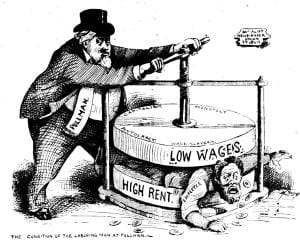Low-wage workers make up nearly half of the American workforce, and many of them are the sole breadwinners for their families.
Last November, the Brookings Institution released a study concluding that nearly half of working age Americans are employed in low-wage jobs. They found that 53 million Americans between the ages of 18 and 64 earned a median wage of $10.22 per hour, or $18,000 per year.
The fact that 44% of the American workforce now finds itself in such a precarious economic situation might come as a surprise to those who imagine low-wage work to be the domain of teenagers, college students, the newly-hired, or those taking on side gigs for extra cash. Instead, these jobs are the main way that many people support their families, especially in smaller cities in the southern and western regions of the United States. 26% of low-wage earners are the sole breadwinners for their household, and another 25% live in households where all earners work in low-paying jobs.
Perhaps the most obvious solution to improving conditions for these workers is to provide education, retraining, and skill upgrades so that they qualify for better jobs. Indeed, 40% of low-wage workers between the ages of 25-64 have, at most, a high school diploma, while another 13% are young people without degrees who are not in school. That means, however, that nearly half of the workers in low-paying jobs already have higher levels of educational attainment.
Simply getting more education won’t cause jobs to magically appear, either. The Occupy movement was full of college-educated people who couldn’t find sufficient jobs to pay back crushing student debt. Perhaps it’s true that “they should have gotten STEM degrees,” (and not those pesky Women’s Studies or sociology majors) as those on the Libertarian/Conservative spectrum self-righteously preached in 2011, but remember how that sentiment morphed into right-wing trolls mocking laid-off “elite” journalists with the condescending mantra of “better learn to code, then” by 2019? (Besides, if everyone learned to code, it would become just another low-wage job.)
Meanwhile, Elizabeth Warren’s efforts to level the playing field by making education more attainable for those lower on the economic spectrum are decried as unfair by conservatives, while President Trump compares himself to Dr. Martin Luther King, Jr., for the “blowout” economy that’s adding mostly low-wage jobs. (Yay?) With wages falling, even the military, traditionally a way for underprivileged young people to work their way up, is now considered to make too much money relative to civilian pay. (Perhaps what this really means is that civilians make too little, relative to military pay, but nobody looks at it that way.)

It’s clear that the existence of the middle class was a historic anomaly. In 2017, MIT economist Peter Temin argued that we’re splitting into a two-class system. There’s a small upper class, about 20% of Americans, predominantly white, degree holders, working largely in the technology and finance sectors, that holds the lion’s share of wealth and political power in the country. Then, there’s a much larger precariat below them, “minority-heavy” but still mostly white, with little power and low-wage, if any, jobs. Escaping lower-class poverty depends upon navigating two flawless, problem-free decades, starting in early childhood, ending with a valuable college degree. The chances of this happening for many are slim, while implementing it stresses kids out and even makes them meaner. Fail, and you risk “shit-life syndrome” and a homeless retirement.
There may not be any good answers. The same eternal growth that would be necessary to constantly increase living standards for everyone is the same consumption that is burning the planet and coating it in carbon and plastic. The Right’s answer is that people should bootstrap themselves up a playing field so uneven that it may as well be vertical. The Left’s answer is to soak the rich, but wealth redistribution can only substitute for growth for a while, and it doesn’t solve the root cause of the problem.
Related: Debt Jubilee: Time for a Clean Slate?


Join the conversation!